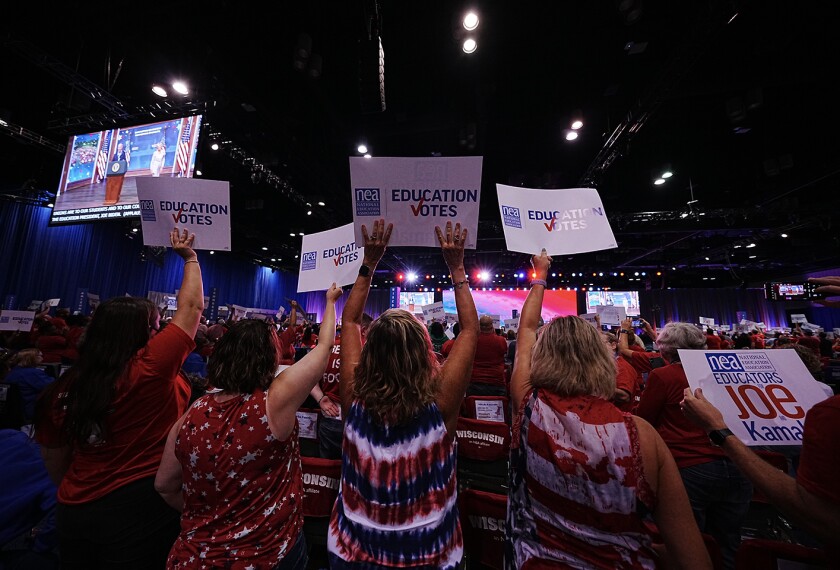Teachers tend to be white, female, and have nearly a decade and a half of experience in the classroom, according to new data released Monday by the federal government.
But there are signs that the nation’s teaching force is gradually growing more diverse. It is also more heterogeneous: The nation’s charter school teachers look significantly different from teachers in traditional public schools.
The U.S. Department of Education has been collecting data on schools, teachers, and administrators through its Schools and Staffing Survey every four years since 1987. This year’s release marks the first since the survey, which was administered to a nationally representative sample of 40,000 teachers, was redesigned. Now called the National Teacher and Principal Survey, the new survey, which includes the same questions as well as some new sections on teachers’ preparation and their influence over school policies, will operate on a two-year cycle.

Among the insights from the newly added sections: Nearly all teachers say they have at least some control over what content and skills they teach, the textbooks they use, the amount of homework they give, and how they evaluate, grade, and discipline students. That’s despite a decade of often tumultuous shifts in both what teachers are expected to teach, and how their classroom acumen is assessed.
The findings paint a national picture of the teaching force—as well as offer insights into how much control teachers feel they have in their classrooms and schools.
“People want to know who teachers are,” said Maura Spiegelman, a statistician for the National Center for Education Statistics, which developed the survey.
Below are some of the highlights of the new findings:
1. The Teaching Force Is Growing and Getting Slightly More Female
The 2015-16 survey estimates that there are 3.8 million public school teachers in the U.S. That’s up from about 3.4 million teachers four years ago, when the last survey was administered. About 3.6 million of the teachers today work in traditional public schools, while about 218,500, or 6 percent, work in charter schools.
About 77 percent of teachers are women—up slightly from 76 percent in 2012. In primary schools, nearly 9 in 10 teachers are women. In high schools, less than two-thirds are.
The average age of teachers is 42, down slightly from 43 in 2012.
The average base salary for a teacher these days is $55,100. Those who earn additional money for leading extracurricular or other activities tend to add about $2,600 to their pay.
2. The Hispanic Teacher Population Is on the Rise
The percentage of white teachers is down and Hispanic teachers is up, both to a statistically significant degree from four years ago, the data show.
About 80 percent of teachers are white, a decrease from 82 percent in 2012. And now 9 percent of teachers are Hispanic, up from 8 percent previously. That could be a reflection of America’s changing demographics—the country has seen a dramatic rise in the Hispanic population. Even so, the teaching force hasn’t kept pace.
About 7 percent of teachers are black and 2 percent are Asian. Those percentages have not changed since 2012.
3. Charter Teachers Have Less Experience Than Traditional Public School Teachers
The data also bring to light some interesting distinctions between those who teach in the charter sector and those who work in traditional public schools. (Charter schools receive public funds but have more autonomy than traditional public schools and may be run by nonprofit or for-profit organizations.)
Enrollment in charters has risen quickly over the last 10 years, though unevenly across the country. Some states, like Nebraska and West Virginia, don’t allow charters at all. In other places, such as the District of Columbia and New Orleans, charters educate a sizeable portion of students.
According to the data, about 14 percent of charter school teachers are Hispanic. In traditional public schools, the percentage is 8.5.
Traditional public school teachers are much more likely to have a master’s degree than their charter school peers (48 percent vs. 38 percent), though debate continues full force over whether the additional education pays dividends in the classroom.
Teachers in traditional schools also tend to be more experienced: They have an average of 14 years teaching under their belts, while charter school teachers have 10.
4. Teachers Feel in Control
Much of the controversy around the Common Core State Standards has hinged on claims that their reading and math goals for students are overly prescriptive, and limit teachers’ ability to make instructional decisions on their own.
But the new data show that teachers still feel at least somewhat in control over what and how they teach.
Ninety-eight percent of teachers reported that they have any control over how they evaluate and grade students, what teaching techniques they use, and how much homework they give.
About 85 percent of teachers said they had any control over selecting the content, topics, and skills they taught. Eighty-four percent said they had some control over choosing textbooks and other instructional materials.





